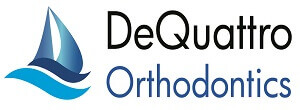Say Goodbye to Misalignments With DeQuattro Orthodontics
At DeQuattro Orthodontics, Dr. Frank DeQuattro and our team’s commitment to your oral health goes beyond aesthetics — it extends to addressing functional concerns that untreated orthodontic issues may pose. Whether you find yourself grappling with misaligned teeth or experiencing jaw pain, understanding common orthodontic issues is the first step towards a healthier, more confident smile.
Delving into the intricacies of orthodontic concerns, we aim to empower you to make informed decisions about your oral health. For personalized assistance or to schedule a consultation, call our Wakefield office at (401) 783-9890 or our Westerly office at (401) 596-2264. Your journey to a confident smile begins with a call!
Types of Common Orthodontic Issues
Malocclusions
Malocclusions refer to misalignments of the teeth or jaw that can affect how the upper and lower teeth fit together.
Overbite
Overbite occurs when the upper front teeth overlap excessively over the lower front teeth. An excessive overbite can lead to issues with the lower teeth, jaw discomfort, and aesthetic concerns.
Underbite
In contrast to an overbite, an underbite occurs when the lower front teeth protrude beyond the upper front teeth. This misalignment can impact speech, chewing, and facial harmony.
Crossbite
Crossbite happens when the upper teeth sit inside the lower teeth when the jaw is closed. It can cause tooth wear, gum recession, and jaw asymmetry if not addressed.
Crowding
Crowding is a common orthodontic issue where there’s insufficient space in the jaw for all teeth to align properly.
Spacing
On the other hand, spacing issues arise when there’s excessive space between teeth, leading to gaps.
Open Bite
An open bite occurs when there’s a gap between the upper and lower front teeth, even when the jaws are closed. This can affect speech and chewing and may contribute to jaw joint problems.
Midline Misalignment
Midline misalignment refers to a situation where the center of the upper front teeth doesn’t align with the center of the lower front teeth. This can impact the overall balance of the smile.
Causes of Common Orthodontic Issues
Orthodontic problems can arise from various factors, and understanding the underlying causes is essential for effective treatment.
- Genetics: Genetic factors play a significant role in determining the size and shape of your jaw, as well as the positioning of your teeth. If parents or siblings have experienced orthodontic issues, there’s an increased likelihood of similar concerns in future generations.
- Developmental Factors: Certain developmental issues during childhood can contribute to orthodontic problems. For instance, habits like thumb sucking, prolonged pacifier use, or tongue thrusting can impact the development of the teeth and jaw, leading to misalignments.
- Thumb Sucking and Other Habits: Prolonged thumb sucking or the use of pacifiers beyond infancy can exert pressure on the developing teeth and jaws, causing them to shift out of alignment. Habits like tongue thrusting, where the tongue pushes against the teeth when swallowing, can also contribute to orthodontic issues.
- Injury or Trauma: Physical injury to the face or jaw can disrupt the alignment of teeth. Trauma, such as a blow to the mouth or face, can lead to misalignments that may require orthodontic intervention for correction.
Signs and Symptoms
Recognizing the signs and symptoms of orthodontic issues is crucial for seeking timely intervention and preventing potential complications.
- Aesthetic Concerns: Visible signs of misaligned teeth or an irregular bite can impact the appearance of your smile, leading to self-esteem issues and social discomfort.
- Difficulty Chewing or Speaking: Orthodontic issues can affect the functionality of your teeth and jaws, leading to difficulties chewing certain foods or causing speech impediments.
- Jaw Pain or Discomfort: Misalignments in the jaw can result in chronic pain or discomfort. This may be felt in the jaw joints and facial muscles or even contribute to headaches.
- Tooth Wear and Damage: Teeth that aren’t properly aligned may experience uneven wear and are more prone to damage. This can lead to issues such as cavities, fractures, and enamel erosion.
Diagnosis and Assessment
Orthodontists use a comprehensive approach to diagnose and assess common orthodontic issues, ensuring an accurate understanding of the individual’s unique dental and facial structure.
- Orthodontic Examination: Our Rhode Island orthodontists conduct a thorough examination of the teeth, jaws, and facial structure. This includes evaluating bite patterns, tooth alignment, and any visible irregularities.
- X-rays and Imaging: X-rays and advanced imaging techniques, such as 3D scans, provide detailed views of the teeth and jaw structure. These images help our orthodontists assess the positions of teeth within the jaw and identify any hidden issues.
- Treatment Planning: Based on the examination and imaging results, we’ll develop a personalized treatment plan. This plan outlines the specific orthodontic issues present, the recommended course of treatment, and the expected duration of treatment.
Orthodontic Treatment Options
Various treatment options are available to address common orthodontic issues, catering to different preferences and requirements.
Traditional Braces
Traditional braces consist of metal brackets attached to the teeth, connected by wires and bands. This time-tested method effectively corrects a wide range of orthodontic issues and allows for precise control over tooth movement.
Invisalign and Clear Aligners
Invisalign and clear aligners provide a discreet alternative to traditional braces. These custom-made, removable aligners gradually move the teeth into the desired positions. They’re popular for their aesthetic appeal and convenience.
Orthodontic Appliances
Specialized appliances, such as expanders or headgear, may be used to address specific orthodontic issues. Expanders, for example, help widen the upper jaw in cases of crowding.
Surgical Interventions
In severe cases, surgical interventions may be necessary to correct complex orthodontic issues. Orthognathic surgery, for instance, can address significant jaw discrepancies.
Prevention Strategies
Orthodontic issues can be prevented or minimized through proactive measures, especially during crucial developmental stages.
Early Orthodontic Evaluation
Early evaluation by an orthodontic professional, typically around the age of seven, allows for the identification of potential issues before they become more complex. Early intervention can guide jaw growth and prevent severe problems later on. If you have any questions about what to expect on your child’s first visit, don’t hesitate to contact us.
Orthodontic Care for Children and Teens
Encouraging good oral habits in children, such as regular brushing and flossing, and addressing habits like thumb sucking early on can contribute to healthier dental development. Orthodontic interventions during the teenage years are common and often more effective due to ongoing growth.
Adult Orthodontics
Orthodontic treatment isn’t limited to children and teenagers. Adults can also benefit from orthodontic interventions, and advancements in treatments, like clear aligners, make it more accessible and discreet for adults.
Retention Phase
After active orthodontic treatment, a retention phase is crucial to maintain the results. This phase may involve using retainers to prevent the teeth from shifting back to their original positions.
Frequently Asked Questions
While some individuals are referred to orthodontists by their general dentists, it’s not always necessary. Many orthodontists offer initial consultations directly to individuals seeking orthodontic evaluation.
Orthodontic treatment can sometimes alleviate jaw pain associated with misalignments. However, individuals experiencing persistent jaw pain should consult both an orthodontist and a dentist to explore comprehensive solutions.
The orthodontic treatment goes beyond cosmetic improvements. It can contribute to better oral health by reducing the risk of cavities, gum disease, and jaw joint issues. Properly aligned teeth are also easier to clean.
Coverage varies among dental insurance plans. Some plans cover a portion of orthodontic treatment, especially for children. It’s advisable to check with your insurance provider to understand your specific coverage.
Take the First Step Towards a Confident Smile!
Embarking on your orthodontic journey is a significant investment in your oral health and self-confidence. If you have further questions or are ready to explore orthodontic treatment options tailored to your unique needs, we encourage you to call our Wakefield office at (401) 783-9890 or our Westerly office at (401) 596-2264.
You can also book an appointment online, and one of our staff will happily assist you. We’re proud to provide services to new and existing patients in South Kingstown, Charlestown, Weekapaug, RI, and surrounding areas.

